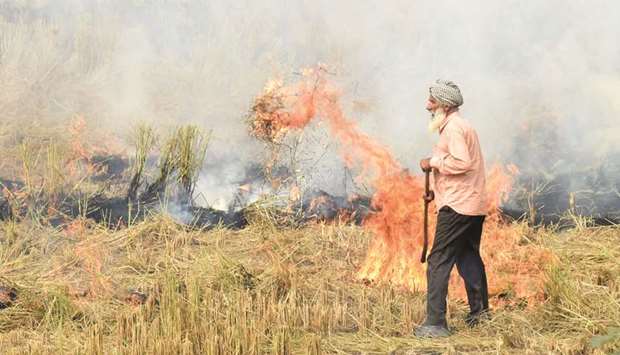The pounding beats of bhangra music blare out of Satish’s tractor as it roars across the charred, black earth of his farm. Fresh seeds are scattered in its wake. Yet hanging thick in the air, over this scene of new beginnings, is the tell-tale smoky stench of what came before.
Like tens of thousands of farmers in India’s northern states of Haryana, Punjab and Uttar Pradesh, Satish, whose farm sits on the outskirts of the rural Haryana village of Gharaunda, had recently cleared his fields of old rice crop stubble to make way for wheat by setting it alight. The practice was banned when its contribution to the mounting pollution crisis in nearby Delhi and across northern India became impossible to ignore, but deprived of equally cheap and easy alternatives of preparing the fields, farmers have continued to flout the law.
As record-breaking pollution threw Delhi into a state of crisis this week, and the city was shrouded in a thick brown smog with toxins over 50 times the levels deemed healthy, crop burning – which began in earnest in late October and is due to continue for the rest of the month – was labelled as the chief culprit. According to the government environment agency, almost 50% of Delhi’s pollution was from crop burning.
“Burning is very common, everyone around here does it and just ignores the laws,” said Satish, who claimed only to be looking after the blackened land, though neighbouring farmers later confirmed he was the owner. “What choice do we have? For most of us this method is the only option to clear our fields. I cannot afford to buy a machine and even to rent it is Rs10,000 (£110), maybe more. To burn it is just Rs1,000 and the next day it is done.”
Enforcement of the law has been lax, with state governments keen to keep the large voting bloc of farmers on side. On Wednesday, over 5,000 crop-burning fires were registered in Haryana and Punjab in a single day and the total over the week exceeded 10,000. While a few farmers in Haryana and Punjab have been issued fines, and some carry out the burning under the cover of darkness, most said they had largely been left undisturbed.
At the Indian Supreme Court on Wednesday, Justice Arun Mishra reprimanded the chief ministers of Haryana, Punjab and Uttar Pradesh for failing to tackle the problem, and ordered them to begin giving financial incentives to farmers who had not burnt their fields. “Punishing poor farmers for burning stubble is not a solution,” said Mishra.
Indeed, across Haryana, farmers remained defensive about their role in northern India’s pollution crisis, arguing they have been both made into scapegoats for a much wider problem and also been expected to switch to more expensive methods and machinery, without any support from the state or national government.
The problems caused by crop stubble have worsened in recent years, because the machines that are now used to harvest the rice leave several inches of stubble in the ground. Even just a few years ago, this excess crop would be used by farmers for cooking, as hay to keep their animals warm or even as extra insulation for homes, but that is increasingly outdated.
Sitting atop his motorcycle looking out over the smoking fields, Sultan Singh, 59, said that farmers had been unfairly demonised for the toxic levels of pollution that engulfed Delhi this week. He had burned his seven acres 15 days earlier.
“I have been burning my crop stubble for the past 25 years,” said Singh. “And even if I have to pay a penalty, I will still burn because it is the only way to get a good harvest and I can’t risk my crops suffering. The government asks us to change our ways, to buy this machine that costs Rs3mn or use methods that are slow, where we make a loss, but then gives us no support or subsidies to help, so nothing is going to change. And people here are already very set in their ways.”
Singh pointed his finger to the sky, where a nearby factory chimney was emitting black fumes into the hazy atmosphere. “Farmers are not responsible for this,” he said angrily. “Look, there are factories pumping out pollution all around us here, all day and all night, all year, whereas we are burning the fields for just a few weeks. They are the ones making the air dirty. But they are not about to shut down the factories, so they need someone to blame.”
Ratam Mann Singh, the Haryana state president of the Indian Farmers Association, was equally damning. “The government is humiliating the farmers, when they have no alternatives,” he said.
Yet this month-long period of crop burning has, yet again, coincided with the worst level of pollution across northern India this year and, while exacerbated by the colder weather that traps the toxic smog over the region, its poisonous environmental impact is indisputable.
Dr Rajinder Singh, the president of a Haryana NGO that promotes agricultural science, said that, in the long term, crop burning was detrimental to farmers as it was “destroying the nutrients in the soil”. He added: “The pollution in Delhi is a secondary issue. Farmers need to be given a viable alternative to crop burning because their own health is suffering the worst from this.”
Ritesh Pandey, MP for the constituency of Ambedkar Nagar in Uttar Pradesh, is among those who have been pushing an agenda of awareness of the damaging impact of crop burning among farmers in his constituency.
“For the past couple of years this issue has affected everybody’s life in north India, not just in Delhi,” said Pandey. “The farmers have been facing a lot of negativity, but it’s not really their fault. They face practical challenges of having a very limited timeframe between one crop (and) another, and thanks to the GM crops the cultivation cycle has shortened, so it’s the government who needs to provide other options and financial incentives to stop stubble burning.”
There has been some shift in behaviour across the region. Shubash Chand, 60, who has been a farmer in Haryana all his life, stopped burning his fields two years ago after he was given a Rs14,000 fine. “But it is a lot more difficult and more expensive for us now,” Chand said with a sigh.
However, in the village of Gudha, a district of Haryana where there have been hundreds of crop fires this year, a group of a dozen farmers sitting in the shade of a tree playing cards all admitted to burning their fields.
Satish Kumar, 39, said that 42 people in the surrounding area had been given fines after they were caught burning their crop stubble, but he said the enforcement was rife with corruption. “If they catch you burning your 10 acres of land, they will only fine you for five acres, but then you have to pay them a bribe, which they pocket themselves,” said Kumar.
“People are burning their fields as much as they have always done,” added Raju Dahaya, 39. “Of course it is better for pollution if we stop. Even if we are disturbed and affected by it, we have watery eyes and breathing issues, but what can we do? But it is not us in isolation. The chief minister of Delhi does not want to deal with the problem of cars and construction, so that’s why he is putting all the blame on us.”

A farmer burns straw stubble after harvesting paddy crops in a field at a village near Sultanpur Lodhi.


